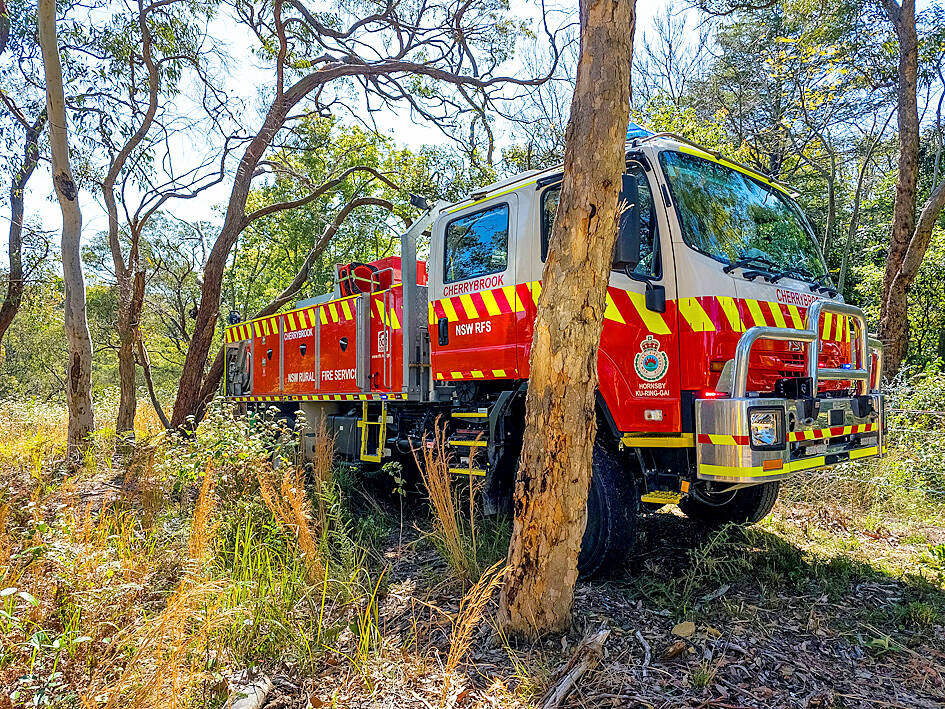Sydney yesterday implemented its first total fire ban in almost three years, while several schools along the New South Wales coast to the south were closed because of a heightened wildfire danger, caused by unusually hot and dry conditions across southeast Australia.
Authorities have forecast the most destructive wildfire season during the approaching southern hemisphere summer in Australia’s populous southeast since the catastrophic Black Summer fires of 2019 and 2020 that killed 33 people, destroyed more than 3,000 homes and razed 19 million hectares.
A total fire ban has been declared for the Greater Sydney area and the coastal communities to the south. It is the first such declaration for Sydney, Australia’s most populous city after Melbourne, since late November 2020.

Photo: Reuters
Sydney yesterday matched its September maximum temperature record of 34.6°C. The Australian Bureau of Meteorology described it as an unusually warm start to spring for much of Australia’s southeast.
“We are in this run of very, very warm weather which hasn’t been seen in many, many years,” bureau senior meteorologist Miriam Bradbury said.
Authorities said 61 wildfires were burning across Australia’s most populous state, with 13 out of control.
Authorities declared a “catastrophic” fire danger along the south coast of New South Wales, the highest level of danger in a five-tier rating system.
“The problem is when we get into fires in ‘catastrophic’ fire danger rating, there’s not much time for us to get on top of those fires and contain them, and once they take hold we won’t be able to put those fires out,” Australian Rural Fire Service Commissioner Rob Rogers said. “We need to warn the community the risk has elevated and make sure that people focus on life preservation on a day like today.”
State education authorities said 20 schools in south coast communities were closed because of the fire danger they were exposed to.
The bureau declared an El Nino, which is associated with hotter and drier conditions across the Australian east coast, after three successive La Nina events brought milder and wetter conditions.
“In all likelihood, we can expect that this summer will be hotter than average and certainly hotter than the last three years,” bureau manager Karl Braganza said.

When Shanghai-based designer Guo Qingshan posted a vacation photo on Valentine’s Day and captioned it “Puppy Mountain,” it became a sensation in China and even created a tourist destination. Guo had gone on a hike while visiting his hometown of Yichang in central China’s Hubei Province late last month. When reviewing the photographs, he saw something he had not noticed before: A mountain shaped like a dog’s head rested on the ground next to the Yangtze River, its snout perched at the water’s edge. “It was so magical and cute. I was so excited and happy when I discovered it,” Guo said.

Chinese authorities said they began live-fire exercises in the Gulf of Tonkin on Monday, only days after Vietnam announced a new line marking what it considers its territory in the body of water between the nations. The Chinese Maritime Safety Administration said the exercises would be focused on the Beibu Gulf area, closer to the Chinese side of the Gulf of Tonkin, and would run until tomorrow evening. It gave no further details, but the drills follow an announcement last week by Vietnam establishing a baseline used to calculate the width of its territorial waters in the Gulf of Tonkin. State-run Vietnam News

Four decades after they were forced apart, US-raised Adamary Garcia and her birth mother on Saturday fell into each other’s arms at the airport in Santiago, Chile. Without speaking, they embraced tearfully: A rare reunification for one the thousands of Chileans taken from their mothers as babies and given up for adoption abroad. “The worst is over,” Edita Bizama, 64, said as she beheld her daughter for the first time since her birth 41 years ago. Garcia had flown to Santiago with four other women born in Chile and adopted in the US. Reports have estimated there were 20,000 such cases from 1950 to

DEFENSE UPHEAVAL: Trump was also to remove the first woman to lead a military service, as well as the judge advocates general for the army, navy and air force US President Donald Trump on Friday fired the chairman of the Joint Chiefs of Staff, Air Force General C.Q. Brown, and pushed out five other admirals and generals in an unprecedented shake-up of US military leadership. Trump wrote in a post on Truth Social that he would nominate former lieutenant general Dan “Razin” Caine to succeed Brown, breaking with tradition by pulling someone out of retirement for the first time to become the top military officer. The president would also replace the head of the US Navy, a position held by Admiral Lisa Franchetti, the first woman to lead a military service,